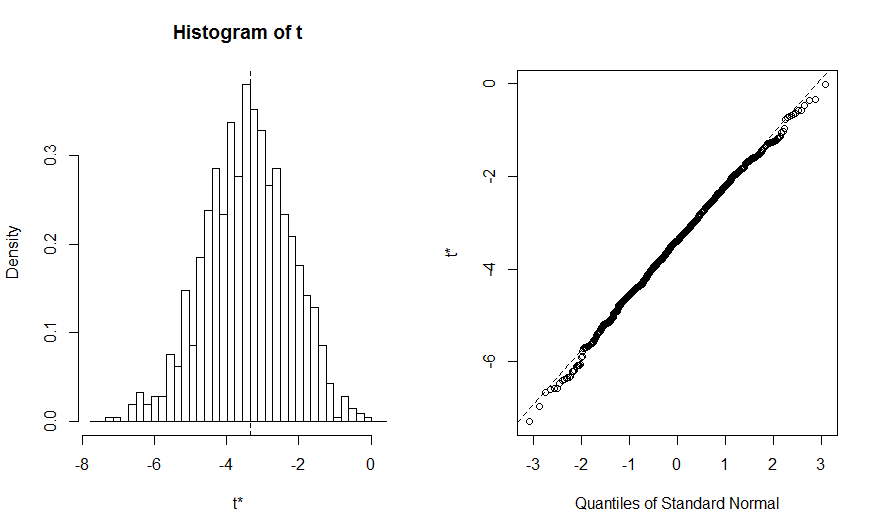>
> library(lmPerm)
> fit<-lmp(weight~height, data=women, perm="Prob")
[1] "Settings: unique SS : numeric variables centered"
> summary(fit)
Call:
lmp(formula = weight ~ height, data = women, perm = "Prob")
Residuals:
Min 1Q Median 3Q Max
-1.7333 -1.1333 -0.3833 0.7417 3.1167
Coefficients:
Estimate Iter Pr(Prob)
height 3.45 5000 <2e-16 ***
---
Signif. codes: 0 ‘***’ 0.001 ‘**’ 0.01 ‘*’ 0.05 ‘.’ 0.1 ‘ ’ 1
Residual standard error: 1.525 on 13 degrees of freedom
Multiple R-Squared: 0.991, Adjusted R-squared: 0.9903
F-statistic: 1433 on 1 and 13 DF, p-value: 1.091e-14
>
>
> library(lmPerm)
> set.seed(1234)
> fit<-lmp(weight ~ height + I(height^2), data = women, perm = "Prob")
[1] "Settings: unique SS : numeric variables centered"
> summary(fit)
Call:
lmp(formula = weight ~ height + I(height^2), data = women, perm = "Prob")
Residuals:
Min 1Q Median 3Q Max
-0.509405 -0.296105 -0.009405 0.286151 0.597059
Coefficients:
Estimate Iter Pr(Prob)
height -7.34832 5000 <2e-16 ***
I(height^2) 0.08306 5000 <2e-16 ***
---
Signif. codes: 0 ‘***’ 0.001 ‘**’ 0.01 ‘*’ 0.05 ‘.’ 0.1 ‘ ’ 1
Residual standard error: 0.3841 on 12 degrees of freedom
Multiple R-Squared: 0.9995, Adjusted R-squared: 0.9994
F-statistic: 1.139e+04 on 2 and 12 DF, p-value: < 2.2e-16
>
>
>
> library(lmPerm)
> set.seed(1234)
> states <- as.data.frame(state.x77)
> fit <- lmp(Murder ~ Population + Illiteracy + Income + Frost, data=states, perm="Prob")
[1] "Settings: unique SS : numeric variables centered"
> summary(fit)
Call:
lmp(formula = Murder ~ Population + Illiteracy + Income + Frost,
data = states, perm = "Prob")
Residuals:
Min 1Q Median 3Q Max
-4.79597 -1.64946 -0.08112 1.48150 7.62104
Coefficients:
Estimate Iter Pr(Prob)
Population 2.237e-04 51 1.0000
Illiteracy 4.143e+00 5000 0.0004 ***
Income 6.442e-05 51 1.0000
Frost 5.813e-04 51 0.8627
---
Signif. codes: 0 ‘***’ 0.001 ‘**’ 0.01 ‘*’ 0.05 ‘.’ 0.1 ‘ ’ 1
Residual standard error: 2.535 on 45 degrees of freedom
Multiple R-Squared: 0.567, Adjusted R-squared: 0.5285
F-statistic: 14.73 on 4 and 45 DF, p-value: 9.133e-08
>
>
> library(lmPerm)
> library(multcomp)
> set.seed(1234)
> fit <- aovp(response~trt, data=cholesterol, perm="Prob")
[1] "Settings: unique SS "
> summary(fit)
Component 1 :
Df R Sum Sq R Mean Sq Iter Pr(Prob)
trt 4 1351.37 337.84 5000 < 2.2e-16 ***
Residuals 45 468.75 10.42
---
Signif. codes: 0 ‘***’ 0.001 ‘**’ 0.01 ‘*’ 0.05 ‘.’ 0.1 ‘ ’ 1
>
>
> library(lmPerm)
> set.seed(1234)
> fit <- aovp(weight ~ gesttime + dose, data=litter, perm="Prob")
[1] "Settings: unique SS : numeric variables centered"
> summary(fit)
Component 1 :
Df R Sum Sq R Mean Sq Iter Pr(Prob)
gesttime 1 161.49 161.493 5000 0.0006 ***
dose 3 137.12 45.708 5000 0.0392 *
Residuals 69 1151.27 16.685
---
Signif. codes: 0 ‘***’ 0.001 ‘**’ 0.01 ‘*’ 0.05 ‘.’ 0.1 ‘ ’ 1
>
>
> library(lmPerm)
> set.seed(1234)
> fit <- aovp(len ~ supp * dose, data=ToothGrowth, perm="Prob")
[1] "Settings: unique SS : numeric variables centered"
> summary(fit)
Component 1 :
Df R Sum Sq R Mean Sq Iter Pr(Prob)
supp 1 205.35 205.35 5000 < 2e-16 ***
dose 1 2224.30 2224.30 5000 < 2e-16 ***
supp:dose 1 88.92 88.92 2032 0.04724 *
Residuals 56 933.63 16.67
---
Signif. codes: 0 ‘***’ 0.001 ‘**’ 0.01 ‘*’ 0.05 ‘.’ 0.1 ‘ ’ 1



